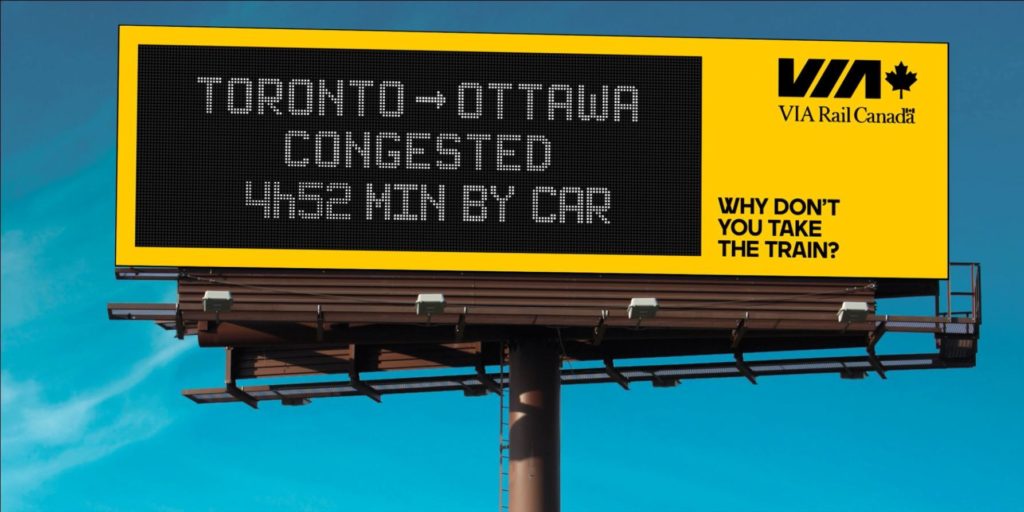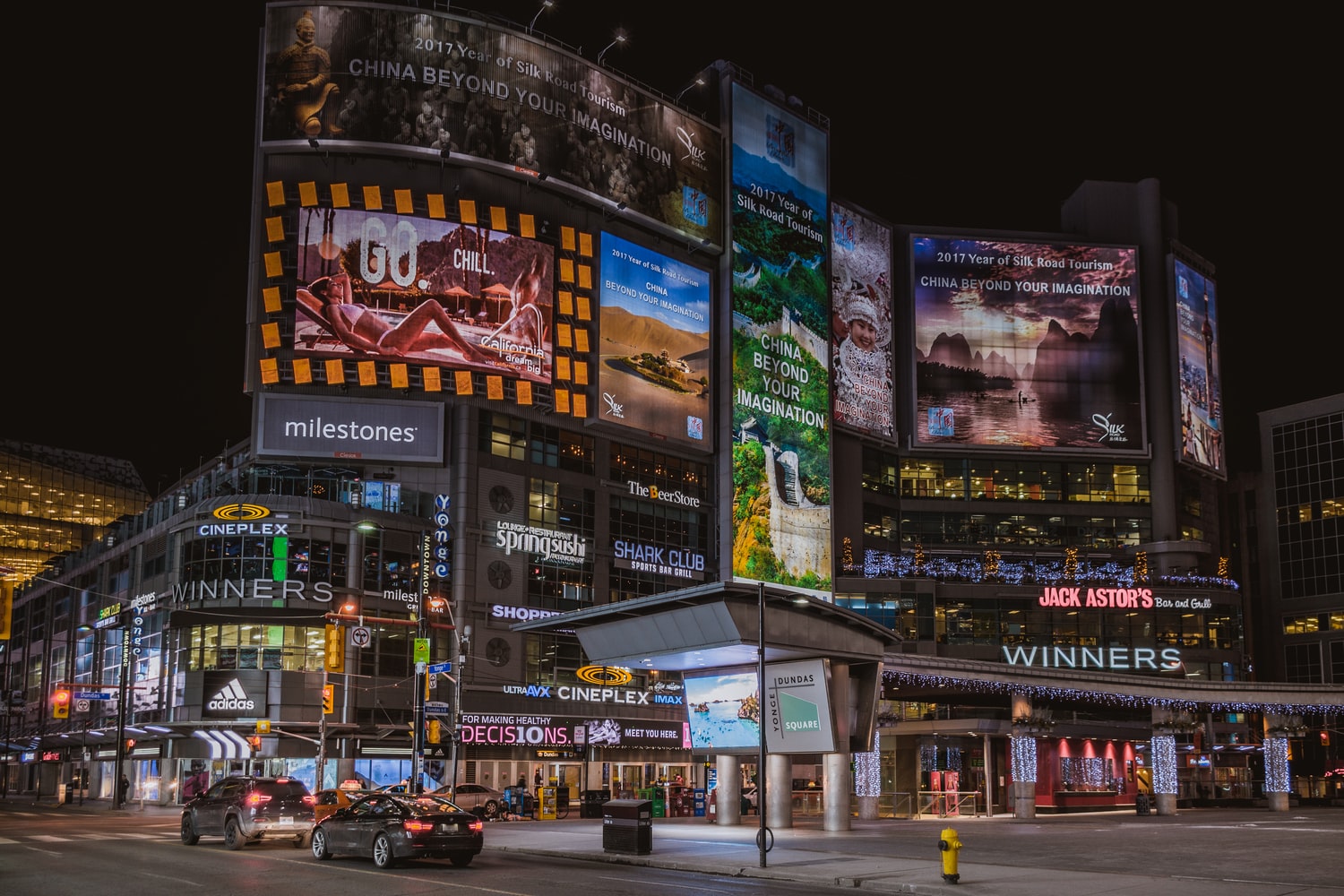Remember last spring when it was nearly impossible to find flour? Or baking soda? These core baking ingredients flew off grocery store shelves as fast as they arrived. Making your own sourdough, pancakes and pies was not just a fad to pass the time. It proved for any recipe to work, it’s essential to have all of the ingredients working together to complete the finished product. Marketing is no different and out-of-home (OOH) is one of those essential ingredients in your marketing mix.
Research consistently shows that brands who activate with the right media combination (recipe!?) make a bigger impact.
To demonstrate why OOH is a required part of your marketing mix, In Partnership With connected with Barbara Huggett. A 20-year media industry executive, Barbara is the General Manager, Canada for Captivate. Captivate is a North American OOH leader that delivers premium video to a captive market. Here, she shares the latest in OOH, how tech and data are changing it, plus what to watch for next.
The Latest in OOH
The last three to five years have seen more reliance in the implementation of location and behavioral data being used. The introduction of programmatic specifically for digital OOH is exciting and has opened many more opportunities for growth. DOOH (digital OOH) includes place based spaces (ie: indoor and entertainment spaces) as well as some large format boards.
Out of home is growing rapidly during COVID because it’s so flexible for media buyers, planners and marketers to use.
With people told not to go to work, theatres and malls shut, things really fell off earlier in 2020. However, traffic is rising and the large format digital ads are recovering the quickest. What we’re all seeing is changes to traffic patterns but exposure to OOH is still there. Fortunately, there is a recovery from a traffic and impression perspective across the board. The worst hit is still is transit although there is some bounce back with the return to school.
A Growing Channel
Overall, growth is projected for the industry due to stronger accountability and new KPIs. In the past, people thought of OOH as only the top of the funnel driving mass awareness. But that is moving down and brands are able to implement OOH into the mid-funnel and the lower funnel to support conversion strategies. The use of cross-device and mobile data in linking OOH has really helped so you can get, for example, foot traffic attribution. That allows more specifics to show people exposed to the OOH ads went by a business; they went into a store and you can see the lift coming from that. So there’s a lot of really intricate, new data opportunities that have helped OOH expand from just that upper funnel. And it’s those types of attributions that prove the value of OOH to marketers.
The adoption of programmatic platforms in buying of DOOH by agencies has also contributed to post-COVID investment. The platforms allow advertisers to be nimble with no minimum spend commitments. Again, use of audience data strengthens targeting for this automated buy.
New Technology is Driving Understanding
What’s exciting for OOH is the latest tech enables us to support customer journey attribution. For instance, polygons or geofences are being leveraged with mobile data to understand who is in a particular area that has OOH advertising visible. A polygon is a precise virtual line which is drawn around the perimeter of a building or specific area. This can be as close as 3 feet where OOH analytics companies can then identify mobile device ID’s within the area.
The power of technology is that you create extremely custom remarketing capabilities.
You are able to take audience insights and serve ads to viewers who have entered specific locations at certain times, days or with a specific frequency. You can now become even more contextual in your messaging, for example, based on different weather in the area. For office buildings, you can use rooftop polygons to capture the devices moving in and out on a regular basis.
As it relates to Captivate, it would be from a Monday to Friday perspective and the algorithms weed out anybody who’s just a visitor and really focuses on the day-to-day office workers. From here, you have a core working audience of device IDs exposed to your ads in the office that you can layer other location and behavioural targeting as well as attribution KPIs to close the loop for advertisers. You can assess different points of interest (retail store, day care, museum etc..) and you’re able to map the device path. If you’ve seen the movie Minority Report, it’s similar but instead of eye scanning, advertising companies are recognizing mobile device IDs at an anonymized level – so not identifying the individual person – and looking for patterns.
OOH Data Capture & Privacy
The connection to Minority Report may make some uneasy from a privacy perspective. Thankfully, there are protections in place so people can have confidence that it’s more macro insights that are being captured. At the same time, there are now opportunities being explored to have people starting to opt in for a value exchange to create even more relevance for them. Currently, many mobile phone users will share their location data with brands, retailers or other service providers. In doing so, they’ll receive extra offers, benefits or promotions.
Increasing Relevance with Data
As data feeds better inform the digital out of home ecosystem, marketers are able to make the message more immersive in the environment where it exists. This could include the basics, such as time of day or temperature. Time of day is interesting for food service providers or restaurants since this can inform relevant dayparts for meals. It could be breakfast in the morning or dinner planning in the mid-afternoon. For temperature, this is valuable since it speaks to types of relevant foods, such as soup for lunch on a cold day or a warm jacket ad when it’s going to be cold tomorrow.
Message and creative relevancy from data feeds is potent to make OOH deliver stronger ROI.
Via Rail, for example, had a great campaign that changed with the weather so their message would only appear when it was advantageous. The messaging focused on taking the train during rush hour, construction season or awful weather. Via would even leverage it on highways if storms were forecasted.

The Future of OOH in Canada
As with every media channel, there’s some changes going on from a media buying perspective. Captivate is seeing shorter lead times right now. It’s a function of budgets being restrained and brands looking to deploy ad dollars efficiently. As a result of COIVD, out of home channels have changed their cancellation policies. They used to be 60 to 90 days. Now it’s within 30 days and that’s to help make marketers feel comfortable about the buys that they’re making.
Brands may have to start looking at planning from a more regional perspective for the next two years.
With COVID, different cities and communities are opening up and closing down at different speeds. Whereas national planning was most common, there’s now a lot of planning based on where things are with COVID rates locally to determine how many people are out and about. As we’ve seen, Vancouver may be in a very different situation than Toronto or Ottawa.
Undoubtedly, OOH measurement will continue to strengthen. To get one true impression measurement across different providers will be helpful. There’s just so many aspects in terms of unique spaces that often deliver on different objectives: restaurants, malls, office, residential and large format. Most OOH providers still have their own third party measurement metrics and systems. There’s a huge opportunity to work with the relevant associations and measurement companies to bring this all together.
Working Together For Collective Growth
Interestingly, the supplier side is working more closely than ever and there’s a lot more communication happening between competitors. These “frenemies” continue to build their own businesses, of course. Yet as a result of COVID, there seems to be more of a push to raising OOH as a channel together. When the industry can expand channel interest – based on educating clients on the significant new opportunities that OOH can deliver on – everyone wins. So the mood out there is “let’s grow the pie” collectively. And that’s a recipe for leaving a good taste in one’s mouth for each OOH company, their employees and the industry overall.
In Partnership With
Barbara Huggett is General Manager of Canada at Captivate with over 20 years of experience in business development, media strategy and client relations. Her role is grounded in her abilities as a relationship builder focused on collaborative partnerships that deliver unique, integrated campaigns to achieve client success. An active contributor to the business community, Barb sits on the B2B Council for the Canadian Marketing Association (CMA).
Tim Bishop, CM is a multi-disciplined executive with a proven record of optimizing strategic efforts to expand the influence of leading organizations, such as the Canadian Marketing Association, Cineplex Entertainment, Lavalife.com, IMI International and Northstar Research Partners. In Partnership With is his latest focus to curate Canadian marketing experts to celebrate the power of strategic partnerships in a perspective-based content series.

